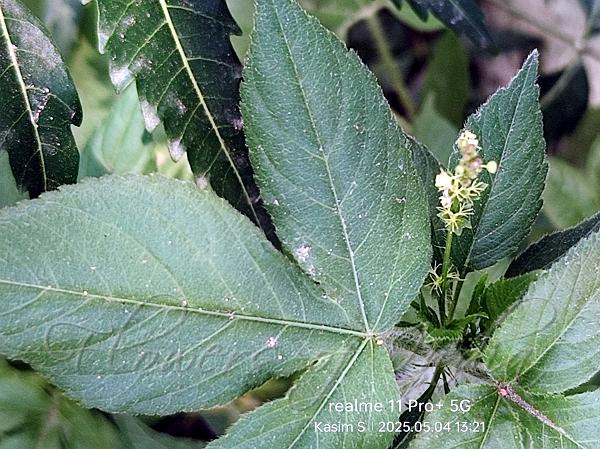|
| Lobed Croton |
|

|

| File size | 867602 |
| Original date | 5/4/25 1:21 PM |
| Resolution | 2048 x 1536 |
| Flash | Flash did not fire, auto |
| Focal length | 6.06mm |
| Exposure time | 1/100s |
| Aperture | 1.69 |
| Focus Distance | |
| Metering Mode | Center weighted average |
| Camera make | realme |
| Camera model | realme 11 Pro+ 5G |
| Sensor type | Undefined |
|
|
|
|
Photo: |
Botanical name: Astraea lobata Family: Euphorbiaceae (Castor family)
Synonyms: Croton lobatus, Astraea palmata, Oxydectes lobata
Synonyms: Croton lobatus, Astraea palmata, Oxydectes lobata
Lobed Croton is an annual, monoecious and herbaceous
plant with hairy and dense branches. The plant is erect up to 1 m tall,
sometimes woody at the base with a long taproot. The leaves are
alternate, with small stipules and palmately 3‐5 lobed. The lobes are
inverted-lanceshaped to obovate in shape, tip tapering with toothed
margins, hairy star-shaped to almost hairless on both sides in some
cases. The inflorescence is a slender, in leaf-axils or at branch-ends
raceme; with small male flowers in the upper half and female flowers in
lower half. The flowers are regular, unisexual, yellowish green in
colour, male flowers with elliptical sepals and inverted-lanceshaped
petals while female flowers have linear- lanceshaped sepals. The fruit
is a globular capsule, star-shaped hairy, green in color with three
ellipsoid seeds. Lobed Croton is native to Mexico to Tropical America,
naturalized in Peninsular India. Flowering: June-September.
Medicinal uses: In Nigeria, the fruit
decoction of Lobed Croton is taken orally mixed with Vernonia
amygdalina leaves and Macaranga barteri leaves as remedy for diabetes.
In Senegal, leaf or whole plant is used as sterilizer or against mouth
infections and whooping cough. In Togo, leaf juice is applied topically
as remedy for eye problems and unconsciousness and the flower, leaf or
root decoction is taken orally for pregnancy problems. In Venezuela,
Lobed Croton is used as haemocatharsis and the entire plant is used as
a hunting poison in the coastal interior of the Ivory Coast.
In Nigeria, the fruit
decoction of Lobed Croton is taken orally mixed with Vernonia
amygdalina leaves and Macaranga barteri leaves as remedy for diabetes.
In Senegal, leaf or whole plant is used as sterilizer or against mouth
infections and whooping cough. In Togo, leaf juice is applied topically
as remedy for eye problems and unconsciousness and the flower, leaf or
root decoction is taken orally for pregnancy problems. In Venezuela,
Lobed Croton is used as haemocatharsis and the entire plant is used as
a hunting poison in the coastal interior of the Ivory Coast.
Medicinal uses:
 In Nigeria, the fruit
decoction of Lobed Croton is taken orally mixed with Vernonia
amygdalina leaves and Macaranga barteri leaves as remedy for diabetes.
In Senegal, leaf or whole plant is used as sterilizer or against mouth
infections and whooping cough. In Togo, leaf juice is applied topically
as remedy for eye problems and unconsciousness and the flower, leaf or
root decoction is taken orally for pregnancy problems. In Venezuela,
Lobed Croton is used as haemocatharsis and the entire plant is used as
a hunting poison in the coastal interior of the Ivory Coast.
In Nigeria, the fruit
decoction of Lobed Croton is taken orally mixed with Vernonia
amygdalina leaves and Macaranga barteri leaves as remedy for diabetes.
In Senegal, leaf or whole plant is used as sterilizer or against mouth
infections and whooping cough. In Togo, leaf juice is applied topically
as remedy for eye problems and unconsciousness and the flower, leaf or
root decoction is taken orally for pregnancy problems. In Venezuela,
Lobed Croton is used as haemocatharsis and the entire plant is used as
a hunting poison in the coastal interior of the Ivory Coast. | Identification credit: S. Kasim | Photographed in Pettai, Tirunelveli, Tamil Nadu. |
• Is this flower misidentified? If yes,